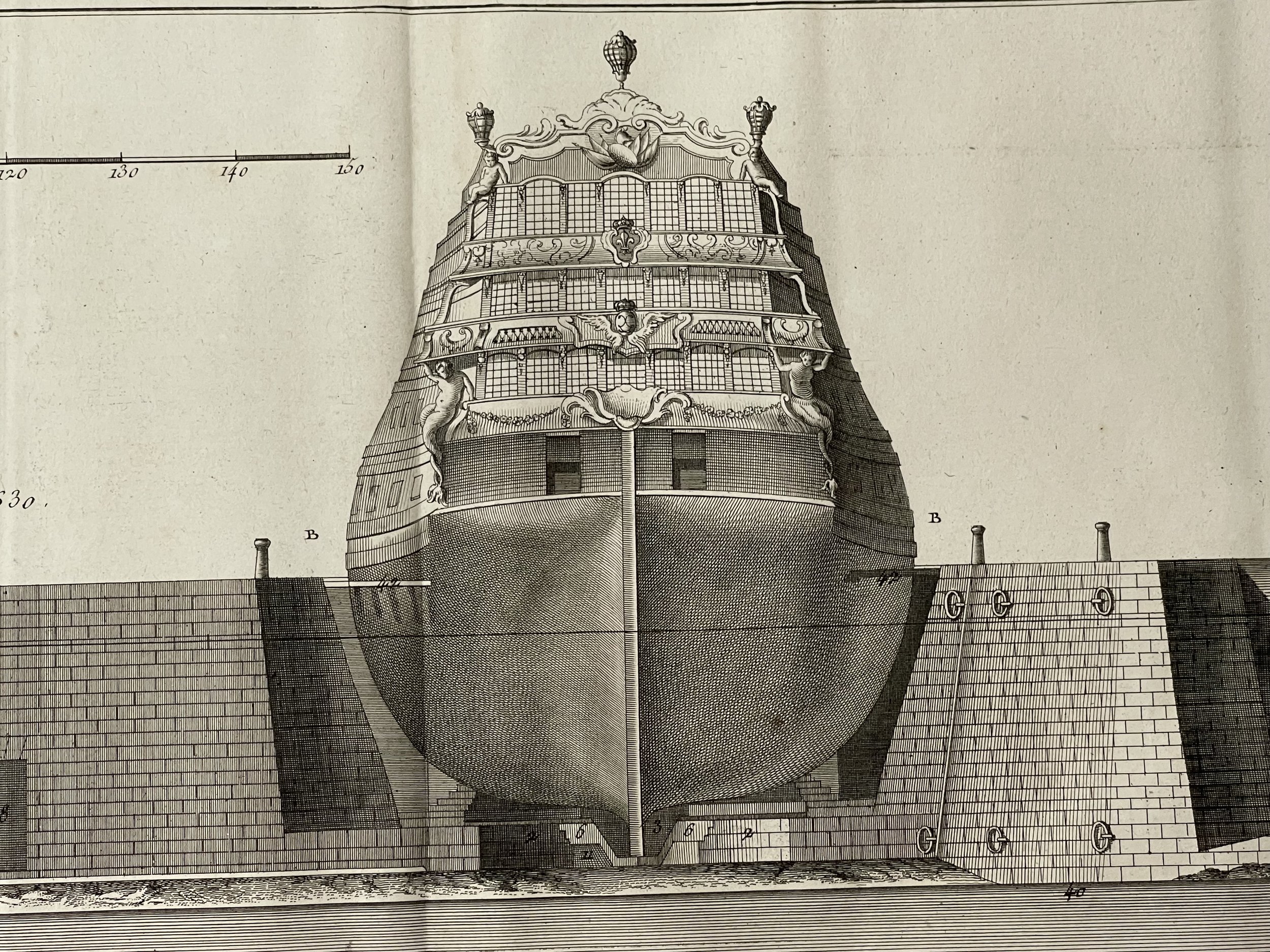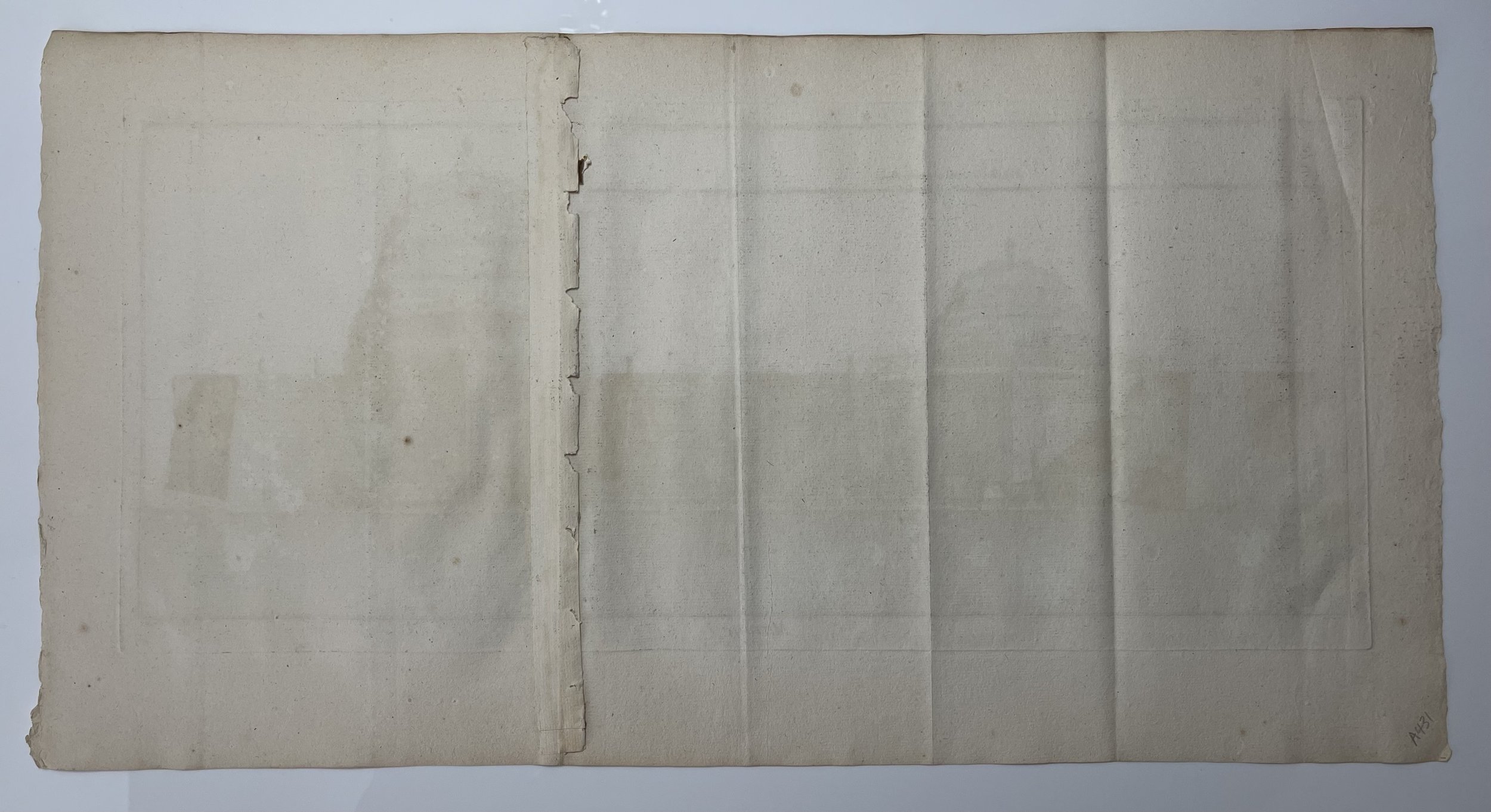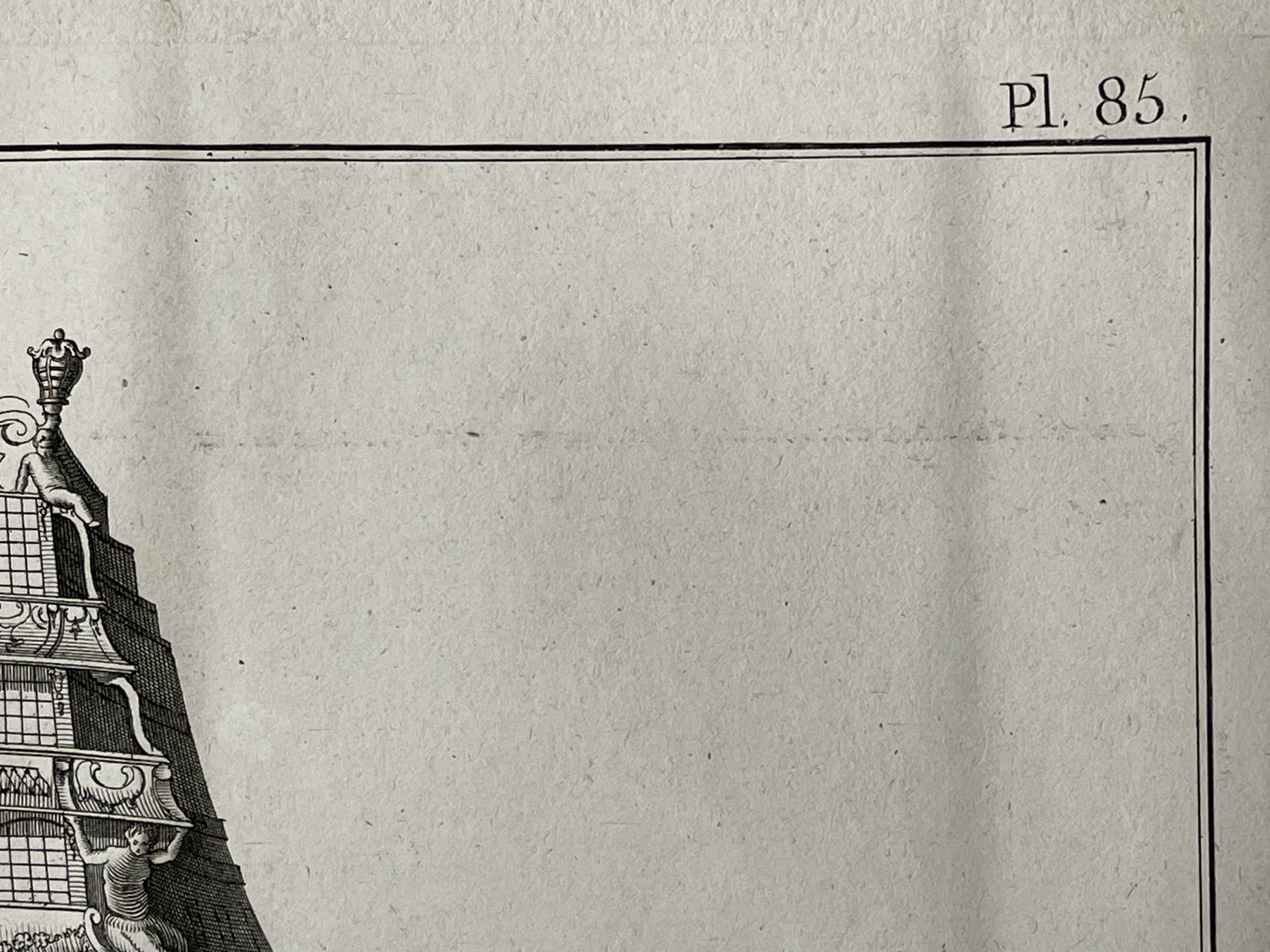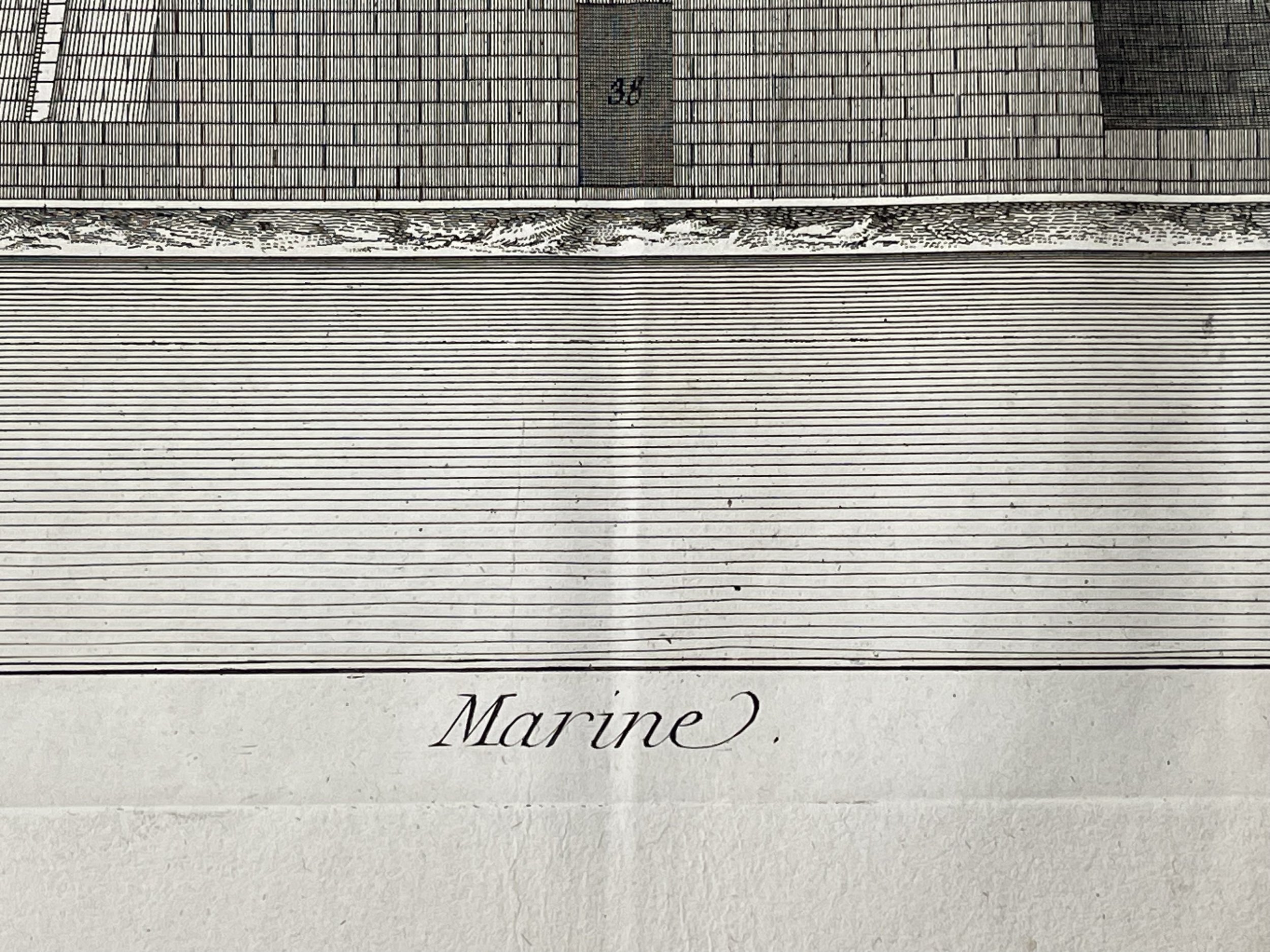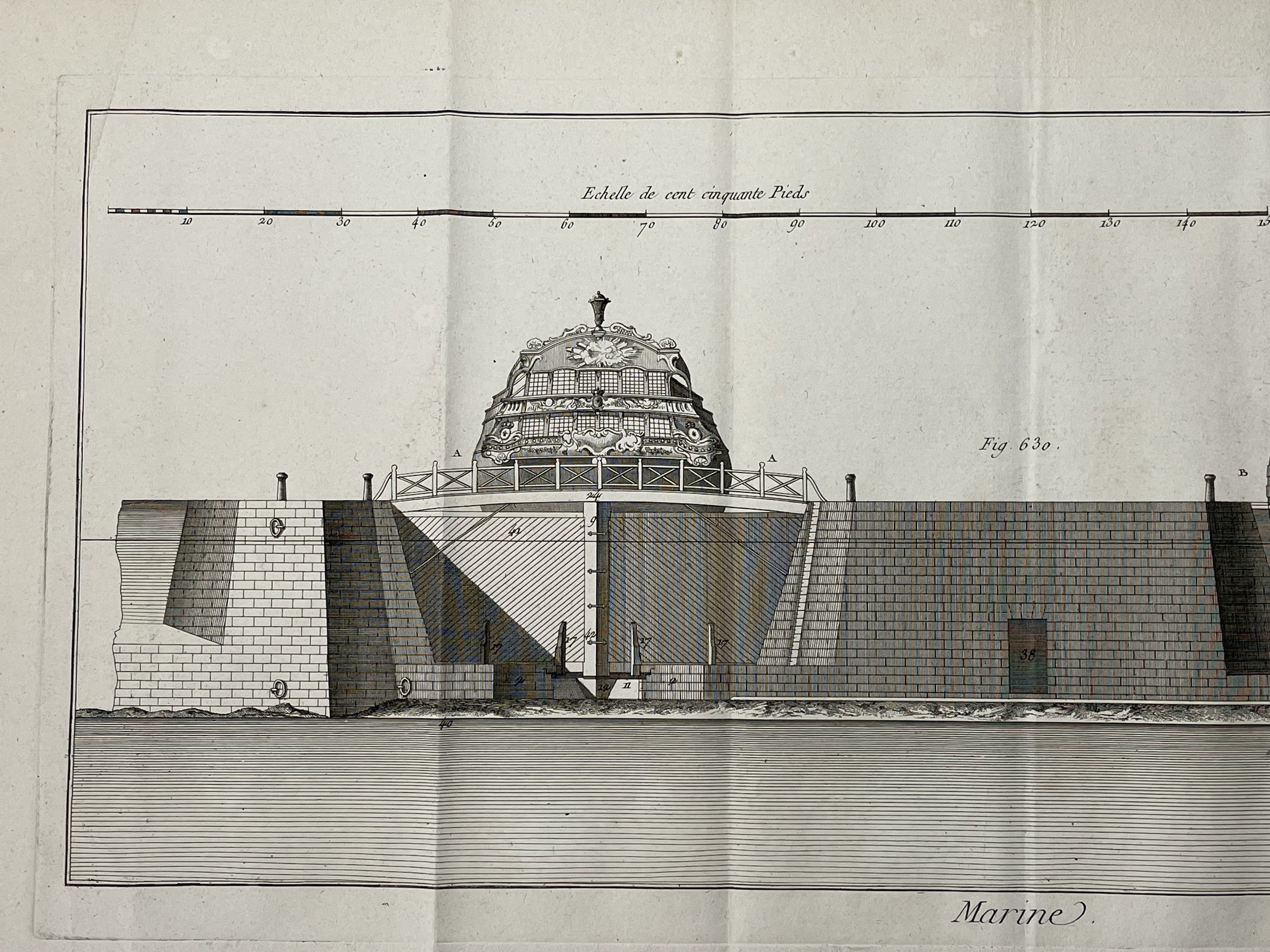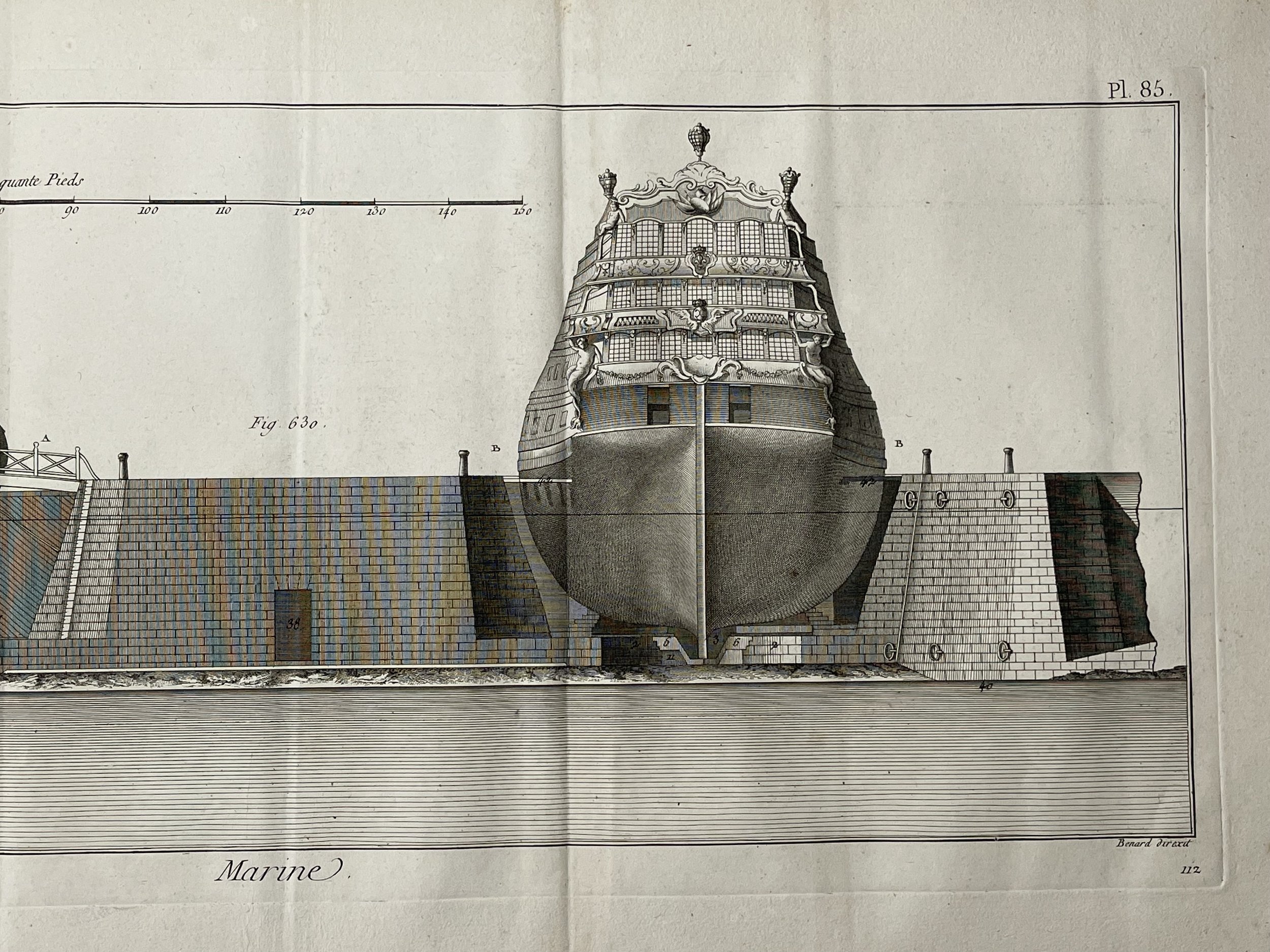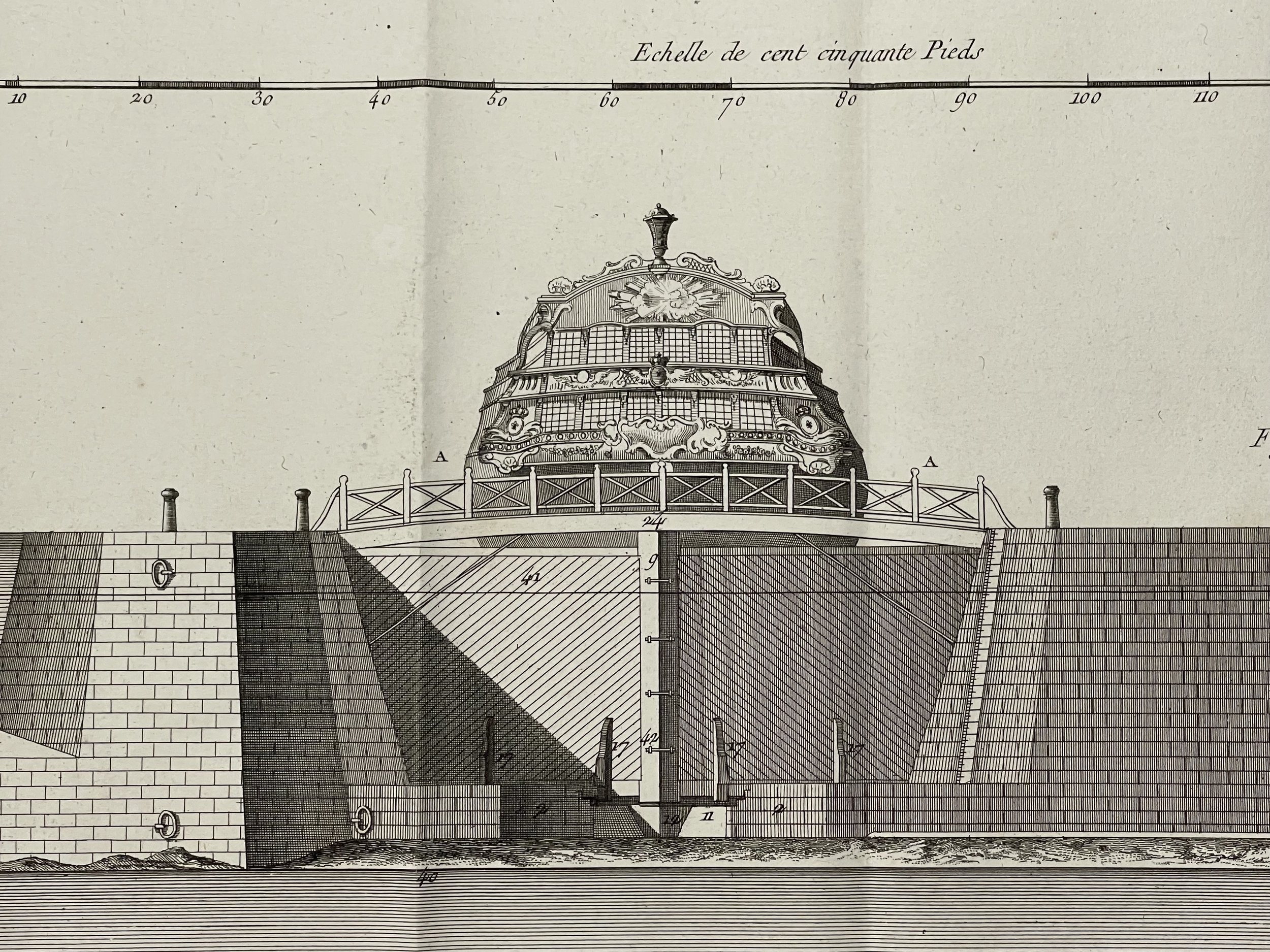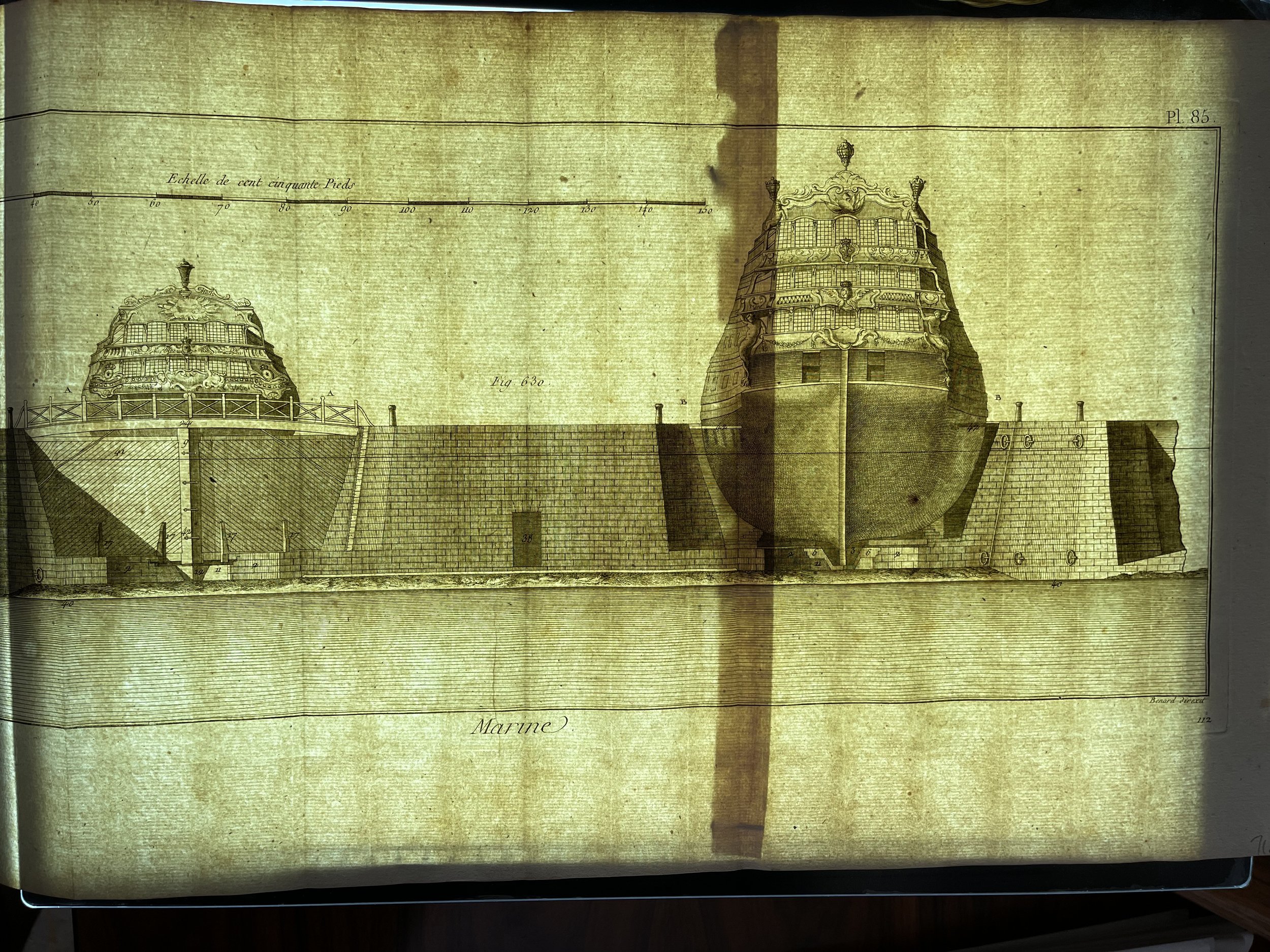Ship Design and Building methods - Charles-Joseph Panckoucke / Jacques Renaud Benard - 1770
Ship Design and Building methods From the Encyclopédie méthodique Maritime Encyclopedia Plate 85 page 112.
Publisher Paris : Panckoucke ; Liège : Plomteux in 1787 containing drawings and blueprints of shipbuilding, and Illustrations of maritime subjects plates drawn by Benard direxit.
The Encyclopédie méthodique par ordre des matières ( 'Methodical Encyclopedia by Order of Subject Matter') was published between 1782 and 1832 by the French publisher Charles Joseph Panckoucke, his son-in-law Henri Agasse, and the latter's wife, Thérèse-Charlotte Agasse. Arranged by disciplines, it was a revised and much expanded version, in roughly 210 to 216 volumes (different sets were bound differently), of the alphabetically arranged Encyclopédie, edited by Denis Diderot and Jean le Rond d'Alembert.
The full title was L'Encyclopédie méthodique ou par ordre de matières par une société de gens de lettres, de savants et d'artistes; précédée d'un vocabulaire universel, servant de table pour tout l'ouvrage, ornée des portraits de MM. Diderot et d'Alembert, premiers éditeurs de l'Encyclopédie.
Charles-Joseph Panckoucke - 26 November 1736 – 19 December 1798) was a French writer and publisher. He was responsible for numerous influential publications of the era, including the literary journal Mercure de France and the Encyclopédie Méthodique, a successor to the Encyclopédie by Denis Diderot.
Panckoucke was born in the city of Lille, where his father André-Joseph Panckoucke (1700–1753) was a writer and book printer. Charles-Joseph settled in Paris in 1754 and established his own bookshop in 1762. He reused many of engraver Robert Bénard's productions to illustrate the works of his catalogue.
His first suggestion of a supplement to the Encyclopédie, in 1769 was turned down by Diderot, but Panckoucke persisted. By 1775, Panckoucke had secured a license to publish his supplement, and it appeared as five volumes in 1776 and 1777. Panckoucke also published two volumes of index to the Encyclopédie, prepared by Pierre Mouchon, and appearing in 1780.
Panckoucke's great effort was the Encyclopédie Méthodique, an expansion and rearrangement of the Encyclopédie, with the subject matter organized by subject area rather than alphabetically. He received the license in 1780 and published a first prospectus in 1782. The work outlived him, with his daughter Thérèse-Charlotte Agasse (widow of Panckoucke's partner Henri Agasse) publishing the last of 166 volumes in 1832.
Shortly before the French Revolution, Panckouke also began publishing the magazine Mercure de France, and established the Moniteur Universel in November 1789. The Mercure de France was a venerable publication of great influence among the French arts and humanities, and it has been called the most important literary journal in prerevolutionary France. He died, aged 62, in Paris.
Panckoucke's son, Charles Louis Fleury Panckoucke, continued in the writing and publishing business as well
Robert Bénard (1734 in Paris – 1794) was a French engraver.
Specialised in the technique of engraving, Robert Bénard is mainly famous for having supplied a significant number of plates (at least 1,800) to the Encyclopédie by Diderot & d'Alembert from 1751.Later, publisher Charles-Joseph Panckoucke reused many of his productions to illustrate the works of his catalog.
Biographical research established in 2019 that his real name was Jacques Renaud Benard, that he was born in 1731 at Rosny-sous-Bois, and that he died in Paris in 1794
The signature "Benard fecit" on plates probably indicates the work of his own hand; the signatures "Benard Direx" and "Benard Direxit" indicate the work of the atelier of engravers he directed for many years.
Ship Design and Building methods From the Encyclopédie méthodique Maritime Encyclopedia Plate 85 page 112.
Publisher Paris : Panckoucke ; Liège : Plomteux in 1787 containing drawings and blueprints of shipbuilding, and Illustrations of maritime subjects plates drawn by Benard direxit.
The Encyclopédie méthodique par ordre des matières ( 'Methodical Encyclopedia by Order of Subject Matter') was published between 1782 and 1832 by the French publisher Charles Joseph Panckoucke, his son-in-law Henri Agasse, and the latter's wife, Thérèse-Charlotte Agasse. Arranged by disciplines, it was a revised and much expanded version, in roughly 210 to 216 volumes (different sets were bound differently), of the alphabetically arranged Encyclopédie, edited by Denis Diderot and Jean le Rond d'Alembert.
The full title was L'Encyclopédie méthodique ou par ordre de matières par une société de gens de lettres, de savants et d'artistes; précédée d'un vocabulaire universel, servant de table pour tout l'ouvrage, ornée des portraits de MM. Diderot et d'Alembert, premiers éditeurs de l'Encyclopédie.
Charles-Joseph Panckoucke - 26 November 1736 – 19 December 1798) was a French writer and publisher. He was responsible for numerous influential publications of the era, including the literary journal Mercure de France and the Encyclopédie Méthodique, a successor to the Encyclopédie by Denis Diderot.
Panckoucke was born in the city of Lille, where his father André-Joseph Panckoucke (1700–1753) was a writer and book printer. Charles-Joseph settled in Paris in 1754 and established his own bookshop in 1762. He reused many of engraver Robert Bénard's productions to illustrate the works of his catalogue.
His first suggestion of a supplement to the Encyclopédie, in 1769 was turned down by Diderot, but Panckoucke persisted. By 1775, Panckoucke had secured a license to publish his supplement, and it appeared as five volumes in 1776 and 1777. Panckoucke also published two volumes of index to the Encyclopédie, prepared by Pierre Mouchon, and appearing in 1780.
Panckoucke's great effort was the Encyclopédie Méthodique, an expansion and rearrangement of the Encyclopédie, with the subject matter organized by subject area rather than alphabetically. He received the license in 1780 and published a first prospectus in 1782. The work outlived him, with his daughter Thérèse-Charlotte Agasse (widow of Panckoucke's partner Henri Agasse) publishing the last of 166 volumes in 1832.
Shortly before the French Revolution, Panckouke also began publishing the magazine Mercure de France, and established the Moniteur Universel in November 1789. The Mercure de France was a venerable publication of great influence among the French arts and humanities, and it has been called the most important literary journal in prerevolutionary France. He died, aged 62, in Paris.
Panckoucke's son, Charles Louis Fleury Panckoucke, continued in the writing and publishing business as well
Robert Bénard (1734 in Paris – 1794) was a French engraver.
Specialised in the technique of engraving, Robert Bénard is mainly famous for having supplied a significant number of plates (at least 1,800) to the Encyclopédie by Diderot & d'Alembert from 1751.Later, publisher Charles-Joseph Panckoucke reused many of his productions to illustrate the works of his catalog.
Biographical research established in 2019 that his real name was Jacques Renaud Benard, that he was born in 1731 at Rosny-sous-Bois, and that he died in Paris in 1794
The signature "Benard fecit" on plates probably indicates the work of his own hand; the signatures "Benard Direx" and "Benard Direxit" indicate the work of the atelier of engravers he directed for many years.
Ship Design and Building methods From the Encyclopédie méthodique Maritime Encyclopedia Plate 85 page 112.
Publisher Paris : Panckoucke ; Liège : Plomteux in 1787 containing drawings and blueprints of shipbuilding, and Illustrations of maritime subjects plates drawn by Benard direxit.
The Encyclopédie méthodique par ordre des matières ( 'Methodical Encyclopedia by Order of Subject Matter') was published between 1782 and 1832 by the French publisher Charles Joseph Panckoucke, his son-in-law Henri Agasse, and the latter's wife, Thérèse-Charlotte Agasse. Arranged by disciplines, it was a revised and much expanded version, in roughly 210 to 216 volumes (different sets were bound differently), of the alphabetically arranged Encyclopédie, edited by Denis Diderot and Jean le Rond d'Alembert.
The full title was L'Encyclopédie méthodique ou par ordre de matières par une société de gens de lettres, de savants et d'artistes; précédée d'un vocabulaire universel, servant de table pour tout l'ouvrage, ornée des portraits de MM. Diderot et d'Alembert, premiers éditeurs de l'Encyclopédie.
Charles-Joseph Panckoucke - 26 November 1736 – 19 December 1798) was a French writer and publisher. He was responsible for numerous influential publications of the era, including the literary journal Mercure de France and the Encyclopédie Méthodique, a successor to the Encyclopédie by Denis Diderot.
Panckoucke was born in the city of Lille, where his father André-Joseph Panckoucke (1700–1753) was a writer and book printer. Charles-Joseph settled in Paris in 1754 and established his own bookshop in 1762. He reused many of engraver Robert Bénard's productions to illustrate the works of his catalogue.
His first suggestion of a supplement to the Encyclopédie, in 1769 was turned down by Diderot, but Panckoucke persisted. By 1775, Panckoucke had secured a license to publish his supplement, and it appeared as five volumes in 1776 and 1777. Panckoucke also published two volumes of index to the Encyclopédie, prepared by Pierre Mouchon, and appearing in 1780.
Panckoucke's great effort was the Encyclopédie Méthodique, an expansion and rearrangement of the Encyclopédie, with the subject matter organized by subject area rather than alphabetically. He received the license in 1780 and published a first prospectus in 1782. The work outlived him, with his daughter Thérèse-Charlotte Agasse (widow of Panckoucke's partner Henri Agasse) publishing the last of 166 volumes in 1832.
Shortly before the French Revolution, Panckouke also began publishing the magazine Mercure de France, and established the Moniteur Universel in November 1789. The Mercure de France was a venerable publication of great influence among the French arts and humanities, and it has been called the most important literary journal in prerevolutionary France. He died, aged 62, in Paris.
Panckoucke's son, Charles Louis Fleury Panckoucke, continued in the writing and publishing business as well
Robert Bénard (1734 in Paris – 1794) was a French engraver.
Specialised in the technique of engraving, Robert Bénard is mainly famous for having supplied a significant number of plates (at least 1,800) to the Encyclopédie by Diderot & d'Alembert from 1751.Later, publisher Charles-Joseph Panckoucke reused many of his productions to illustrate the works of his catalog.
Biographical research established in 2019 that his real name was Jacques Renaud Benard, that he was born in 1731 at Rosny-sous-Bois, and that he died in Paris in 1794
The signature "Benard fecit" on plates probably indicates the work of his own hand; the signatures "Benard Direx" and "Benard Direxit" indicate the work of the atelier of engravers he directed for many years.
Code : A431
Cartographer : Cartographer / Engraver / Publisher: Charles-Joseph Panckoucke / Jacques Renaud Benard
Date : Publication Place / Date - 1770
Size : Sheet size: 61.5 x 32 cm
Availability : Available
Type - Genuine - Antique
Grading A
Where Applicable - Folds as issued. Light box photo shows the folio leaf centre margin hinge ‘glue’, this is not visible otherwise.
Tracked postage, in casement. Please contact me for postal quotation outside of the UK.

